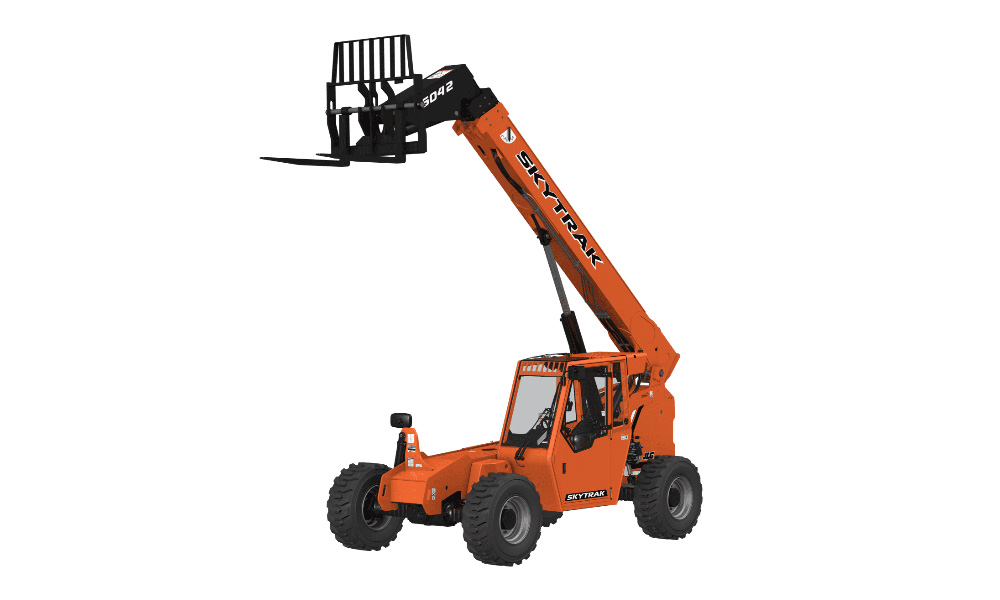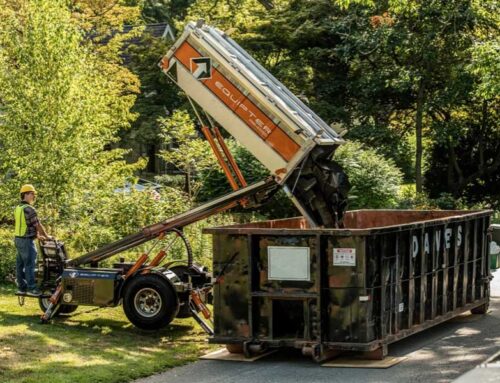We are excited to announce the addition of telehandlers to our rental fleet.
Whether used for agriculture applications or on a construction site, a telehandler is one of the most common industrial pieces of equipment. Also, knowns as Telescopic Forklifts, telehandlers consist of a telescopic boom handle and offers more reach and power than a forklift with similar maneuverability. Telehandlers are useful for many different construction projects.
Telehandlers are four-wheel drive. Telehandlers are capable of lifting high capacity loads of material.
It is important that you get the right piece of equipment for the task you need completed. There are several factors that you should consider when renting a telehandler for your job.
1. Capacity – It is essential that you rent a model that can handle more weight than the load sizes you plan to move. Exceeding the lifts capacity, can put your crew in danger. Also, you need to keep in mind that the weight capacity is lower when the telehandler boom is at maximum height or reach.
2. Height – Maximum lift height dictates how far you can lift loads vertically and they differ based on weight capacities.
3. Reach – Similar to the height measurements, the maximum reach also depends on weight capacity and is a crucial factor to consider. The reach dictates how far you can extend the boom in forward, horizontal direction.
4. Turning Radius – You’ll need to consider your crew’s workspace before deciding on a rental, as maneuverability is important to your operators. The turning radius will determine how well the operator will be able to move around a jobsite.
5. Boom Pivot Pin – Beyond the capabilities of the equipment, some of the significant design differences may matter to your operator. One of these differences is the position of the boom pivot pin. High-pin designs position the boom over the operator, requiring them to look under it when transporting loads. Low-pin styles are the opposite, where operators view over the boom. The positioning also determines how the equipment works best, as low-pin types are better for carrying loads closer to the ground while high-pin styles work better for lifting. Our telehandlers are high-pin style telehandlers.
6. Steering – If you want to have a versatile steering system, make sure you rent a telehandler that has the three modes — front-wheel, four-wheel and crab. This is the only piece of equipment that comes with these three varieties. With the front-wheel setting, only the front two wheels shift to turn the body, much like a car. It’s safe to use on roads and works well in open areas. Four-wheel steering allows for a much tighter turning radius, as it uses all four wheels to rotate the body, and is better suited for crowded areas. The crab setting is hardly steering at all. It allows the operator to rotate all four wheels in the same direction, which means the telehandler can move diagonally or side to side to position the boom precisely.
For a thorough idea of which kind of telehandler and what features to choose, you should at least answer these questions:
1. What Are You Planning to Lift and Where?
Depending on what your crew will be using the telehandler to lift, you can accurately choose what weight capacity you’ll need. Have an idea of how much a single load of your materials might weigh, then be sure to rent a telehandler with an extended boom weight capacity over that amount. If you come too close to the absolute maximum, you may put your crew in danger.
2. Does Your Operator Have the Required Training?
Training is essential to maintaining workplace safety, especially around large, heavy lifting equipment. If your operator doesn’t have the required training for telehandlers, they must have it before using one around your worksite. They should at least have ANSI Aerial Lift and OSHA Telehandler certifications.
If your operator hasn’t had the proper training, your operator must take complete the necessary training before scheduled delivery of the lift. Make sure your operator takes a course that includes pre-operation inspection, procedures for starting and shutting down the equipment, actions in case of emergency, general daily operations and hands-on experience, culminating in a test.
3. What Type of Telehandler Is Best for Your Operator?
It’s impossible to know what will best suit your team’s needs without thoroughly analyzing your work situation. Every detail matters, but the top four to look into the most are:
- Environment: The area where you plan on using a telehandler is an important part of your decision.
- Time of day: Working on construction sites during the night requires added precautions and more specialized equipment. Outdoor daytime projects are naturally well lit. If your crew is working after dark, they should have equipment with active headlights for their safety and the safety of others.
- Uses: One of the most decisive factors is what you intend to lift with your telehandler and how far it needs to go. The weight, load size and shape of the materials will dictate what model you should rent as well as what attachments you should have alongside the traditional lift.
- Comfort: Ultimately, your operator is the one who will be spending the most time in the telehandler. It’s essential to know their comfort levels and factor that information into your decision. You should give your crew their best chances for efficiency and success, so consulting them will pay off in the long run.
Call us today to learn more about telehandlers and the other aerial lift equipment in our rental fleet.


